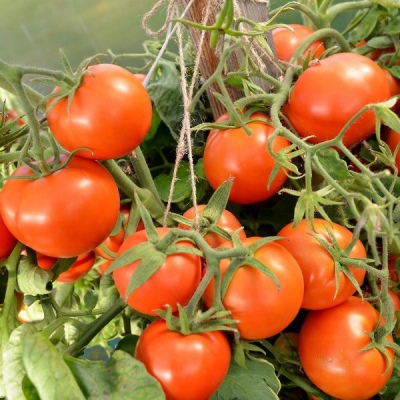
- Category: grade
- Growth type: determinant
- Appointment: fresh consumption, for pickling and preserving
- Ripening period: early
- Ripening time, days: 78
- Growing conditions: for open ground, for closed ground
- Bush size: undersized
- Bush height, cm: 50-60
- Branchiness: weak
- Foliage: medium
The seedling tomato is a bright representative of determinant crops. But for its simple inflorescences to please farmers with a good harvest, it will not be enough to work thoroughly. We still have to study the features of this plant properly, to exclude the occurrence of errors.
Description of the variety
The seedless tomato forms undersized bushes. Their size does not exceed 50-60 cm. Branching is rather weak. The number of leaves is moderately high. The leaves themselves are of medium size, dark green in color; it is also worth considering that this culture belongs to the standard group.
The main qualities of the fruit
Freshly formed Seedling tomatoes are colored normal green. Ripe berries are characterized by a red color. The mass of a single tomato varies from 50 to 80 g. In shape, the fruit resembles a flat circle; his ribs are not too pronounced. From 5 to 8 tomatoes develop on 1 brush, and the stalk has a characteristic articulation.
Taste characteristics
In the reviews of farmers, the sweetness of the seeds of the Seedless variety is noted. Sour notes are uncharacteristic for them. The pulp is rather fleshy. The harvested crop can be used for making salads.
Ripening and fruiting
Seedless - one of the earliest tomatoes. He can ripen on average 78 days after discarding the green growth. You can start harvesting from mid-June. Sometimes, under adverse weather conditions, the beginning of fruiting occurs in the second half of June. The collection can last until the end of September, which is very popular with most gardeners.
Yield
The declared ability to produce up to 8 kg of tomatoes per 1 sq. m. To achieve such a result, it is not necessary to take particularly difficult actions. The usual agrotechnical works are quite enough.
The timing of planting seedlings and planting in the ground
You need to prepare containers for seedlings and place seeds in them in March. Transplanting to greenhouses takes place in April or May. If you decide to plant a crop in an open garden, you must wait for June. Specific terms are determined only by the gardeners themselves, taking into account objective factors and the state of the plants.

Growing tomato seedlings is an extremely important process, because it largely depends on whether the gardener will be able to harvest at all. All aspects must be taken into account, from seedbed preparation to planting in the ground.
Landing scheme
It is necessary to place such a culture on the site according to the proven rule of 300x500 mm. Departure from it is not allowed. It is better not to plant plants at all than to grow them too densely or extremely scattered. For 1 sq. m should not have more than 6 bushes.

Growing and care
The seedless tomato does not need:
pinching;
garter;
special shaping.
The seeds of this plant are recommended to be treated with developmental stimulants before planting. The best predecessors are zucchini, cucumbers, carrots, parsley and dill. Transplanting and picking for a seedless tomato is not a problem. It is necessary to water the culture every 7-10 days, and always with warm water. Watering too often can be downright harmful.
Drip irrigation is welcome. To make the ovary more numerous, it is recommended to spray the culture with a solution of boric acid. For feeding, it is best to take complex fertilizers. They need to be applied twice during the growing season. In the spring, it is preferable to lay nitrogen mixtures.




A plant needs different micronutrients at each stage of growth. All fertilizers can be divided into two groups: mineral and organic. Folk remedies are often used: iodine, yeast, bird droppings, eggshells.
It is important to observe the rate and period of feeding. This also applies to folk remedies and organic fertilizers.
Disease and pest resistance
Suppliers of planting material declare that this variety will not be affected by late blight. But gardeners and gardeners will benefit from taking the usual precautions.


Resistant to adverse weather conditions
The cultivar can survive severe drought. Cold weather resistance is low.
Growing regions
The seedless tomato can be cultivated in:
Leningrad and Moscow regions;
regions of the Far East;
Kursk, Voronezh, Tambov regions;
Astrakhan, Volgograd regions;
Bashkiria and Mordovia;
regions of the Urals, Western and Eastern Siberia.
Review overview
Seedless tomatoes, according to gardeners, are not only quite fruitful, but also beautiful. The consumer qualities of the fruit are quite high. Even in bad weather, the collection rate is relatively stable. The crop ripens well in greenhouses and in open areas, and individual fruits can also ripen after being removed from the bush.

























































































